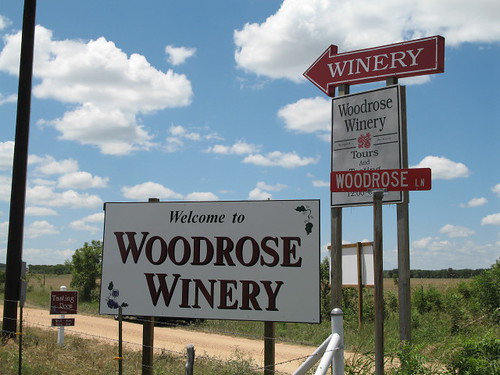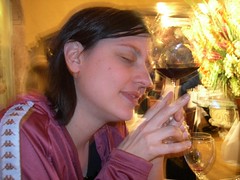Interview: Mike Guilete, Woodrose Winery

Woodrose is out in Stonewall, Texas on the Enchanted Trail, quite close to the larger Becker Vineyards spread and in a very strategic place indeed. Mike Guilete, who bought the winery and its vineyards last year, plans to make it a destination rather than a casual stop just for a sip of chenin blanc. By 2008, the Guiletes plan to expand the property into a "full running resort", complete with stone walkways around a fountain, a 3,000-square foot deck around the tasting room, and a Bed and Breakfast. The tasting room is set up restaurant-style, so there's no struggling against a mob at the bar trying to get a pourer's attention.
Interview with Mike Guilete, owner and winemaker, Woodrose Winery
Cork and Demon: Tell me what you do now and how you got started with Woodrose.
Mike: Predominantly I make computer chips for a living, but I've been fascinated by wineries and the wine business for a long time, so last year, I bought Woodrose Winery. Brian Wilgus was the previous owner and did a really good job of creating a small vineyard, small winery, and I feel like a lot of my charter is to expand on his vision: finish out the vineyard, add additional tanks, and just try to produce a nice, medium quality wine at a reasonable price that people can come in and just enjoy.
What do you have in the vineyard now?
At this point I grow cabernet, merlot and sauvignon blanc, and then I purchase a lot of grapes from other vineyards...I brought in chenin blanc last year and some merlot so I can get a more diverse line, and I brought in some additional cabernet so I could make a rose.
Talk about where you see your winery in the Texas market.
My goal is to make...a medium quality wine. It's a weird way to define it...I want a really high quality wine, but an approachable wine. So I want a wine that people can walk in and aren't that knowledgeable and can enjoy a decent cab or merlot that's not overwhelming in complexity and flavor.
What do you think is so intimidating about wine to the people who visit you?
First and foremost, I think they're intimidated by the process. They feel like they're overwhelmed by the number of choices and the ritual of how you pick a wine. And I think, when you spend a little time and explain to them the reasons you taste things the way you do, to try to pick up some of the aromas and accentuate the flavors, a lot of people find that it's not that intimidating.
Why did you set up shop here in Texas? Why not California or Oregon?
There's two parts to that. As I started researching and learning about it, I thought there was a lot more opportunity to grow with the Texas market than there was with California or Oregon or Washington. I think the expectation out there is you buy a winery and do your best not to mess it up. They've got the experience, they've got the knowledge. I think there's a chance to learn along with the Texas wine industry. The other part is, if you look around, Texas has a lot longer of a history with wine than most people understand. We were growing grapes long before California, yet we've lost all of that. When you read the history you realize there is a lot of potential to really make good wine. Part of our problem is we lost that heritage, and then we try to copy California's style. So over time I think we have to learn how to create our Texas style of wine.
What are some of the challenges the Hill Country faces, both with growing grapes and making wine?
First, we have elements of nature that are kind of against us. Pierce's disease, the most notable, you run the risk of losing your entire vineyard. On top of that our weather: we tend to get big swings of cold at the beginning of the season and a lot of changes in water and heat. So we have more variation in the grape itself than you would see in a California wine, vintage to vintage, and that's something we have to take into account. The other thing that I see is a struggle balancing the wines that sell to people that are new to wine versus those who have been around for a long time, and are looking for a fine wine to appreciate. So it's hard for me to define a style I want to have in terms of winemaking and where I want to take it.
What style of wine do you like?
I tend to like a full-bodied cabernet, something with a fair amount of complexity, I like a little oak in it. I like it when the next day, you can remember the flavor. It doesn't have to be a lot of weird complexity or spices, I'm not looking for different fruit flavors, I just want something that really triggers a response.
Where do you see yourself as a winemaker in five years?
Where I'd like to see myself in five years is having a reputation as a winemaker who consistently makes approachable, drinkable wines. The kind that people would be comfortable recommending to their friends. It's going to be something that from year to year is consistent and from bottle to bottle, you know what to expect and what you get.
****
The bottle 'La Cigale', a lovely blend of tempranillo, grenache and mourvedre, bears the name Woodrose Winery, but I learned that this was not Mike's wine. Made by a woman named Benedict Rhyne, the remaining stock of it was bought along with the property. I also learned that it may have been blended with a finished wine to boost color. Now, that's not my favorite thing to hear, but it beats the hell out of Mega Purple.
Be sure to stop by and comment. This trek into Texas is about discussion, people. So discuss.
Be sure to stop by and comment. This trek into Texas is about discussion, people. So discuss.
Clinkies.





5 Comments:
La Cigale is 37% Martins' Vineyard Grenache and 43% Martins' Vineyard Mourvedre. 80% Texas High Plains Fruit. It's 10% Tempranillo, 7% Cabernet Sauvignon, and 3% Syrah of unknown origin.
Béné is another person you should talk to. . .
Thanks for the clarification. I usually fall asleep after 80%.
Wouldn't it be nice if the full varietal blend were revealed on bottles of wine?
Cheers...and thanks for being part of the discussion!
75% is the key number. You can do a lot of finagling with 25% or a wine, but at least everyone in the US is on a level playing field if they choose to use foreign fruit. I don't think that California allows ANY out of state fruit in a California labeled wine.
You might have noticed that Australian wines almost always contain complete blending percentages. I think that if an Aussie wine mentions more than one varietal, it has to reveal the %. If labeled as a single varietal, I'm not sure, but you see a lot of percentages on Down Unders these days.
Thanks for the welcome. I wish I had been at my folks when you conducted the interview.
hi im sam,
Im from australia, but i have spent the last 3 summers working with benedict rhyne at ste genevieve winery as assistant winemaker in west texas, i have also had the pleasure of meeting Mike Guilete. Woodrose Winery is a fantastic boutique winery with great potential to expand to a fantastic tourist attraction. Benedict's La Cigal Wine was a brilliant easy drinking wine with a wonderful finish. I hope to be back there soon. Cheers SAM
video poker trainer
Post a Comment
<< Home